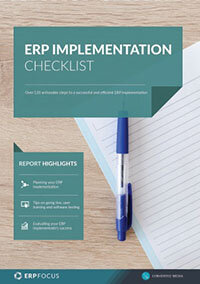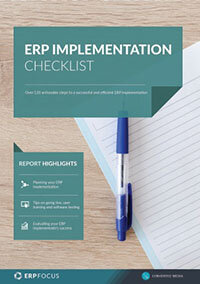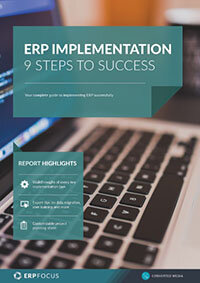The 7 deadly sins of ERP implementation - and how to avoid them
Organizations derive multiple benefits from implementing an ERP solution. The biggest gains are usually seen in improved visibility, which can lend unprecedented insight into an organization’s various units. An integrated approach improves strategy, tactical execution and decision-making among executives and managers.
While an ERP can transform an enterprise into a well-oiled machine, those inexperienced with such a solution can make mistakes that will cost them dearly in the long run. Deploying and maintaining an ERP is no joke, as it requires expertise and effort, not to mention monetary resources. Here are a few big mistakes in ERP implementation – the so-called seven deadly sins – and a few tips on how to avoid committing them.
1. Sticking with a stock deployment
Even if an ERP provider says that their solution works “right out of the box,” do not think for even a second that it’s actually going to do that. Sure, you can probably get all the bells and whistles running marginally out of the box, but you’re going to have to do some customization if you want to get anything done properly. When you first deploy it, an ERP does not know what you want yet. You have to mold it into something that does what you want it to do. Think of the software as a blank canvas. It needs your masterful hand in order to transform into something useful.
Get over120 actionable steps to implementation success with this ERP implementation checklist
Tip: Try looking for a vendor or partner that can assist you in the deployment process and get your ERP to work in a way that is best for your particular needs.
2. Taking the ‘walled garden’ approach
A lot of organizations like to compartmentalize the tools they use into tiny comfortable boxes. The problem is that this isn’t the way an ERP implementation should work. To fully exploit the benefits of enterprise systems, you have to embrace interoperability and integration. It’s the reason why many companies selling ERP software also provide customer relationship management (CRM) and supply chain management (SCM) applications, along with a handful of other systems. An ERP system can tie together a multitude of other solutions that you’re using, establishing the groundwork for greater efficiency.
Tip: Try finding a way to integrate your ERP into your other systems. In fact, you could do a clean sweep integration of all of these tools from the same vendor, guaranteeing maximized interoperability on multiple fronts and ensuring that your ERP communicates in the way that it should.
3.: Not looking beyond ERP
How much do you know about your customer’s behavior and preferences? Multiply that by ten and you will understand the power of using ERP with big data analytics. Your ERP is just going to show you a bunch of data that you must read like a spreadsheet if it doesn’t know how to organize it. Business intelligence and big data analytics tools help to considerably reduce the burden placed on your shoulders when interpreting business information that has been gathered over a period of time. Making sense of your data helps you visualize relationships between dispersed sets of information and understand correlations, such as at what hours a certain item sells on a Friday, and what demographic buys it the most, and so forth.
Tip: Certain tools like SiSense help you map all of your data a provides a no-nonsense visual representation of it all. By connecting the multiple data sets in your organization, you get a crisper image, with insights into relationships that you may not have previously noticed.
4. Neglecting the update
If someone tried selling you a copy of Windows 98 today, you’d probably run in the opposite direction at an impressive speed. The same attitude should be applied to ERP software. It’s no different. Legacy ERP software can be riddled with bugs and internal inefficiencies that make it sub-par for forward-thinking organizations. Worst of all, it’s already been a long time since its security has been upgraded and — like older versions of just about anything else — it is probably vulnerable to a plethora of malicious software and attackers. If you’re using something more current, it’s still important to update it consistently.
Tip: Regular maintenance makes an ERP happy, which in turn makes a business happy. Just keep that in mind.
5. Taking the DIY route with updates
If you’ve ever spent a lot of time around ERP systems, you know that updates involve some level of risk. Such a huge suite of software is going to make the update process unwieldy at best, catastrophic at worst. One patch applied in the wrong manner can break a lot of things, such as the ERP’s communication with your CRM. Any number of problems can occur, and you need to be prepared for each and every one of them. Then, when you’re done, get ready to realize about a week later that something very subtle, but important was broken.
Tip: Use an enterprise automation tool. It will take care of the entire nuanced update and implementation process, and snuff out all of the breaking points that could cause you trouble along the way. Panaya’s cloud-based approach can give you a helping hand with the update process, ensuring that Salesforce, SAP, and Oracle testing goes through without the typical hurdles associated with this kind of endeavor.
6. Not mitigating changes in workflow
Deployments, upgrades, and patches require you to stay one step ahead of all the changes you are introducing. If you neglect to brief everyone on how their day-to-day workflow has changed as a result of an upgrade or switch, their jobs just suddenly became a nightmare for at least the next few days. Sometimes, switching or upgrading your ERP platform may require a full restructuring of business processes to accommodate the shift.
Tip: When you make any changes, do everything you can to find out how it might affect each employee, from the lower rungs upwards. You may need to re-train some employees so that you can have productivity up to snuff. Otherwise, the ERP no longer serves its purpose. Don’t let it be an impedance when it shouldn’t be.
7. Playing by the rules
With most software, you can safely assume that everything is going to function as it should, so you can just sit back and relax. An ERP implementation, on the other hand, is an entirely different beast. By falling into the same cycle of complacency as you would with any other software, you are severely limiting how much ERP can help you.
Tip: Adoption isn’t the end of deployment. You were interested in an ERP because it can help you have more control over your business. Sitting back and letting it “do its thing” is not an option. To reap the rewards, you have to control the ERP. During deployment, don’t leave all the handiwork to the consultants. Instead, have the final word in what happens at this stage and be clear about how you want to use it.
Free white paper

ERP Implementation Checklist
Over 120 actionable steps to implementing a new ERP successfully

Featured white papers
-

ERP Implementation: 9 steps to success
The 9 proven steps you should follow when implementing ERP
Download -

ERP Implementation Checklist
Over 120 actionable steps to implementing a new ERP successfully
Download -

Manufacturing ERP Implementation Checklist
Over 70 actionable steps to rolling out new manufacturing ERP software
Download
Related articles
-

The case for multi-tier ERP implementations
Learn more about multi-tier ERP implementation and why you might need one
-

Secret KPI: Why Your ERP Implementation Team Matters More Than Software
Learn how Godlan ensures successful ERP implementation for manufacturers with proven strategies &...
-

An example ERP implementation team structure for your project
Learn about three key elements of an ERP implementation team and the individuals who contribute w...

